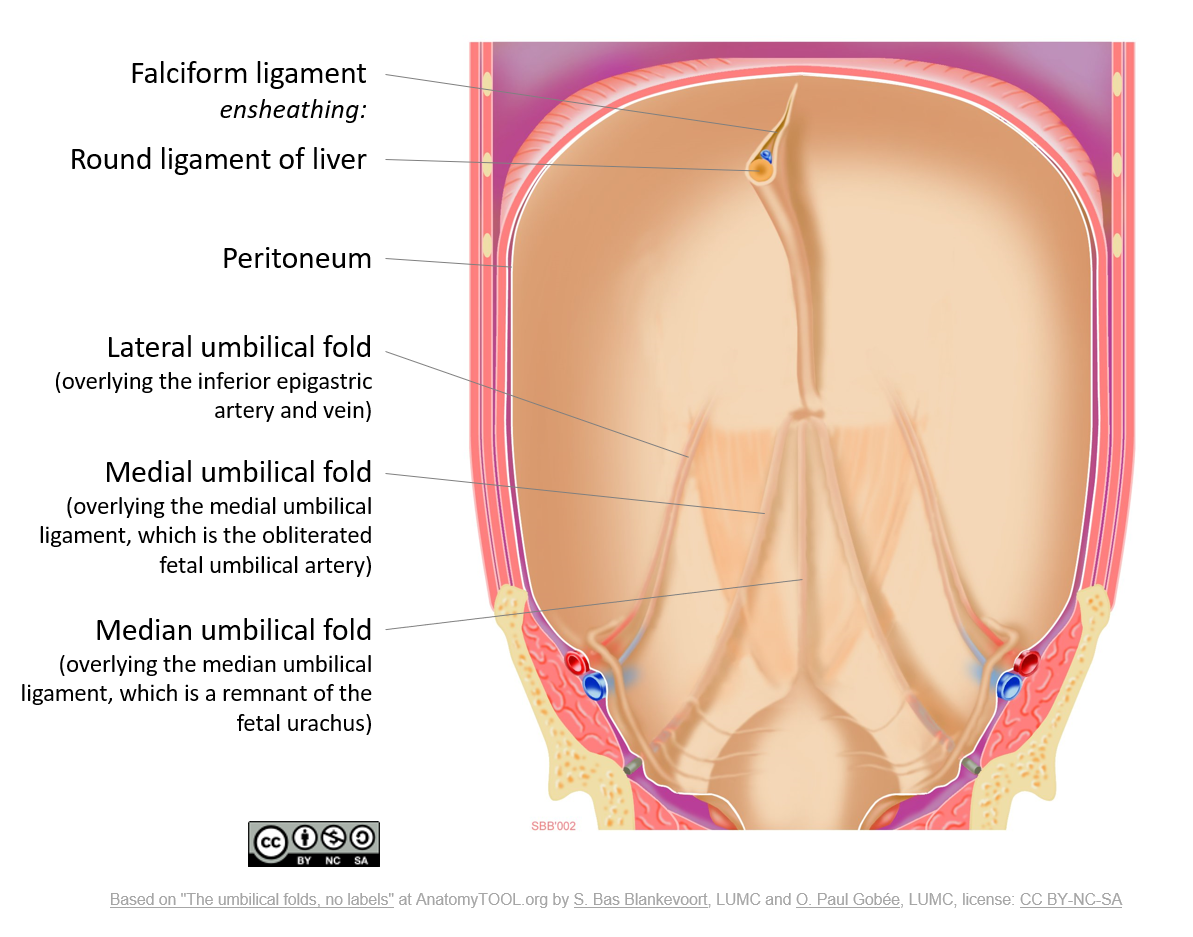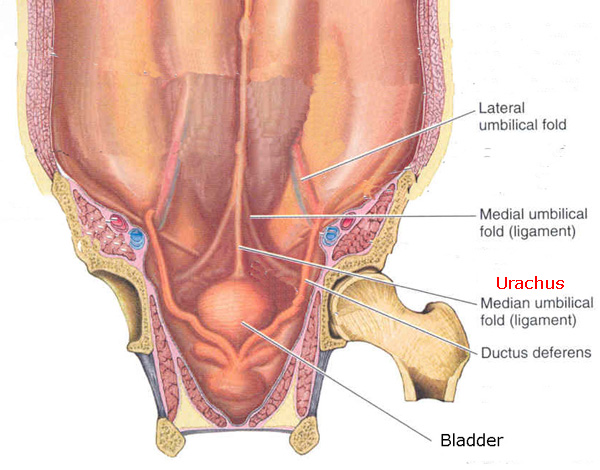The medial umbilical ligament is an anatomic structure present in the human body that exists as a remnant of blood vessels that were important to fetal circulation. There are also check ligaments restricting the vertical movements but the expansions of these muscles are thinner and less distinct than those of the horizontal recti muscles.

Unit 28 Inguinal Region Internal Surface Of Anterolateral Abdominal Wall Flashcards Practice Test Quizlet
The most common type was the median umbilical ligament terminated by joining one or both medial umbilical ligaments Type II 411.

. The medial umbilical ligament is a paired structure found in human anatomy. It is on the deep surface of the anterior abdominal wall and is covered by the medial umbilical folds. The medial umbilical ligamentor cord of umbilical artery or obliterated umbilical artery is a paired structure found in human anatomy.
It is different to the median umbilical ligament a structure that represents the remnant of. The intercellular material or matrix is produced by the cells and gives the tissue its particular character. The paired medial umbilical folds pass from the pelvis to the umbilicus and cover the underlying medial umbilical ligaments.
It is different from the median umbilical ligament a structure that represents the. The medial umbilical ligaments are anatomical remnants of the obliterated foetal umbilical arteriesThe folds are 2 of the 5 umbilical folds and should not be confused with the single midline median umbilical fold. These ligaments are all that remain of the umbilical cord.
The paired medial umbilical folds pass from the pelvis to the umbilicus and cover the underlying medial umbilical ligaments. It is on the deep surface of the anterior abdominal wall and is covered by the medial umbilical foldsplicae umbilicales mediales. Lateral to this structure are the medial umbilical ligament which is.
Median umbilical ligament - Ligamentum umbilicale medianum. It then becomes the urachus in the fetus. This fold is formed by the underlying median umbilical ligament.
It is also known as the cord of the umbilical artery. The median umbilical fold is a raised ridge of parietal peritoneum in the deep aspect of the anterior abdominal wall overlying the median umbilical ligament urachal remnant. The folds are 2 of the 5 umbilical folds and should not be confused with the single midline median umbilical fold.
Mean age was 821 years ranging between 56 and 96 years with a male-to-female ratio of 141. Inguinal swelling due to rare external supravesical hernia--a case report. The median umbilical ligament has.
Lateral to this structure are the medial umbilical ligament and the lateral umbilical ligament. It is covered by the median umbilical fold. It contains the urachus which is an embryonic remnant resulting from involution of the allantoic duct that.
This area usually contains the fundus of the distended urinary bladder and can be clinically significant owing to the fact that the supravesical hernias can arise here. The medial umbilical ligament or cord of umbilical artery or obliterated umbilical artery is a paired structure found in human anatomy. It extends from the apex of the bladder to the umbilicus on the deep surface of the anterior abdominal wallIt is unpaired.
The intraperitoneal view has the medial umbilical ligament as the lateral border of the bladder and the lateral umbilical ligament helps identify the inferior epigastric vessels. Ninety-two per cent was white and 8 per cent black adults. By birth the urachus is obliterated and becomes a vestigial structure known as.
Hereof what are the medial umbilical ligaments remnants of. The supravesical fossa is the area of abdominal wall between remnant of urachus Median umbilical ligament and remnant of left or right umbilical artery medial umbilical ligament. Click to see full answer.
It is a remnant of the fetal urachus. It is a shrivelled piece of tissue that represents the remnant of the embryonic urachus. The median umbilical ligament is a structure in human anatomyIt is a shrivelled piece of tissue that represents the remnant of the embryonic urachus.
The medial umbilical ligaments are anatomical remnants of the obliterated foetal umbilical arteries. The bilateral supravesical fossae lie between the median and bilateral medial umbilical folds. The median umbilical ligament is a structure in human anatomy.
An umbilical cord is a thick blood-rich cord that connects a baby to its mother during the gestation process. The median and medial umbilical ligaments form a peritoneal depression on each side of the urinary bladder referred to as the supravesical fossae. The urachus connects the dome of the bladder to the umbilical cord during fetal life and is located behind the abdominal wall and anterior to the peritoneum in the space of Retzius.
Paired medial umbilical ligaments run along other side with a matching set of lateral ligaments. The median umbilical ligament is a fibrous band located in the anterior portion of the abdomen anterior to the urinary bladder. Round hepatic median and medial ligaments umbilical ring umbilical and umbilicovesicular fasciae and pattern of attachment to the ring were dissected and measured.
It extends from the apex of the bladder to the umbilicus on the deep surface of the anterior abdominal wall. It is also formed from the cloaca in utero. It is important to distinguish between the medial vs median umbilical ligaments.
The median and medial umbilical ligaments were classified into four types based on their interrelationships. The median umbilical ligament begins as the allantois in the embryonic period. The median umbilical ligament runs down the lower portion of the front of the abdominal wall.
The remnants of an embryonic communication between the allantois and cloaca. The vertex of the bladder is joined to the umbilicus by the remains of the urachus which forms the middle umbilical ligament a fibromuscular cord broad at its attachment to the bladder but narrowing as it ascends. It is on the deep surface of the anterior abdominal wall and is covered by the medial umbilical folds plicae umbilicales mediales.
Lĭgəmənt strong band of white fibrous connective tissue connective tissue supportive tissue widely distributed in the body characterized by large amounts of intercellular substance and relatively few cells. The median umbilical fold runs superiorly from the apex of the bladder to the umbilicus. The medial rectus is attached to the lacrimal bone medial check ligament and the lateral rectus to the zygomatic bone lateral check ligament.
The medial umbilical ligament is the aforementioned paired structure related to the umbilical arteries while the median umbilical ligament contains the urachus. This later develops into the median umbilical ligament at birth. Median medial lateral.

Median Umbilical Ligament Wikipedia

Medial Umbilical Ligament Wikiwand

Testpress Medical This Is One Of The Most Confusing Questions Asked In Embryology But For Those Who Can Spend Time To Understand It This Is For An Easy Retention And
:background_color(FFFFFF):format(jpeg)/images/library/13444/BbSCSuvYy55YkvWLz75uw_Medial_umbilical_ligament__2_.png)
Medial Umbilical Ligament Anatomy Branches Supply Kenhub

Medial Umbilical Ligament Wikipedia

The Umbilical Folds And Ligaments English Labels Anatomytool

Mcat Memoranda Umbilical Folds Median Medial And Lateral Are

0 comments
Post a Comment